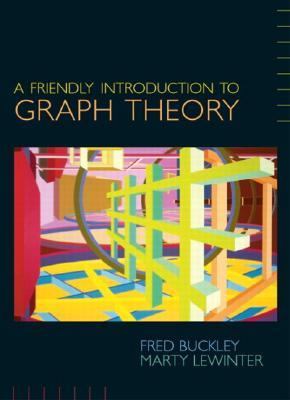129881
9780130669490
Friendly Introduction to Graph Theory
by Buckley, Fred, Lewinter, Marty
Out of Stock
The item you're looking for is currently unavailable.
Product details
- ISBN-13: 9780130669490
- ISBN: 0130669490
- Publication Date: 2002
- Publisher: Prentice Hall PTR
AUTHOR
SUMMARY
Graph theory is a delightful subject with a host of applications in such fields as anthropology, computer science, chemistry, environmental conservation, fluid dynamics, psychology, sociology, traffic management, and telecommunications, among others. With the advent of operations research in the twentieth century, graph theory has risen several notches in the esteem in which it is held. Formally a branch of combinatorics, graph theory intersects topology, group theory, and number theory, to name just a few fields. While its theorems and proofs range from easy to almost incomprehensible, graph theory is, after all, the study of dots and lines! Because of its wide range of applications, it is important that students in many diverse fields, not just mathematics and computer science, gain a foundation in the basics of graph theory. By doing so, they will have additional powerful tools at their disposal to analyze problems within their own area of study. We have written this text mainly with those students in mind and designed it to be easily accessible to undergraduate students as early as the sophomore level. We assume nothing more than a good grasp of algebra. Thus,A Friendly Introduction to Graph Theoryprovides early access to this wonderful and useful area of study for students in mathematics, computer science, the social sciences, business, engineering--wherever graph theory is needed. The student will find this text quite readable. This book should be read with pencil and paper nearby--it is not bedtime reading. The exercises reflect the contents of the chapter and range from easy to hard. Answers, solutions, or hints are supplied in the back of the book for a wide selection of the exercises. It is important to realize that mathematics is not a spectator sport (although it can be fascinating to watch someone present a surprisingly simple proof of an interesting result). Do the exercises, or you will not retain the material of the nth chapter as you attempt the (n+l)-st. A bonus to the diligent students who work through the more challenging exercises is that those students will develop a strong foundation for research in graph theory and an ability to apply the concepts learned to a wide range of real-world problems. Content In Chapter 1, we discuss basic prerequisite concepts and ideas that the reader should be familiar with. Although it is meant as a review, a somewhat thorough treatment is given to provide the necessary tools for understanding the material that will be examined throughout the rest of the book. Thus we discuss topics such as sets, functions, parity, mathematical induction, proof techniques, counting techniques, permutations and combinations, Pascal's triangle, and combinatorial identities. For those readers unfamiliar with proof techniques, this introductory chapter will be particularly helpful. In a class of better-prepared students, the instructor may choose to skip some or all of the contents of Chapter 1. As mentioned earlier, graphs have a wide variety of applications. In Chapter 2, we introduce the most basic concepts of graph theory and illustrate some of the areas where graphs are used. We will see many other applications throughout the book. One class of graphs is so important that it deserves treatment in its own chapter. Because of their simple structure, trees are often used as a testing ground for possible new theorems. Trees arise in many applications, such as analyzing business hierarchies and determining minimum cost transportation networks, and are the basis of important data structures in computer science. A tree is a special type of graph in a larger class called bipartite graphs. In Chapter 3, we examine trees, bipartite graphs, and their uses. The chapter concludes with an application to job assignment problems. The concept of distance is widely used throughout graph theory and its applications. Distance is useBuckley, Fred is the author of 'Friendly Introduction to Graph Theory', published 2002 under ISBN 9780130669490 and ISBN 0130669490.
[read more]



